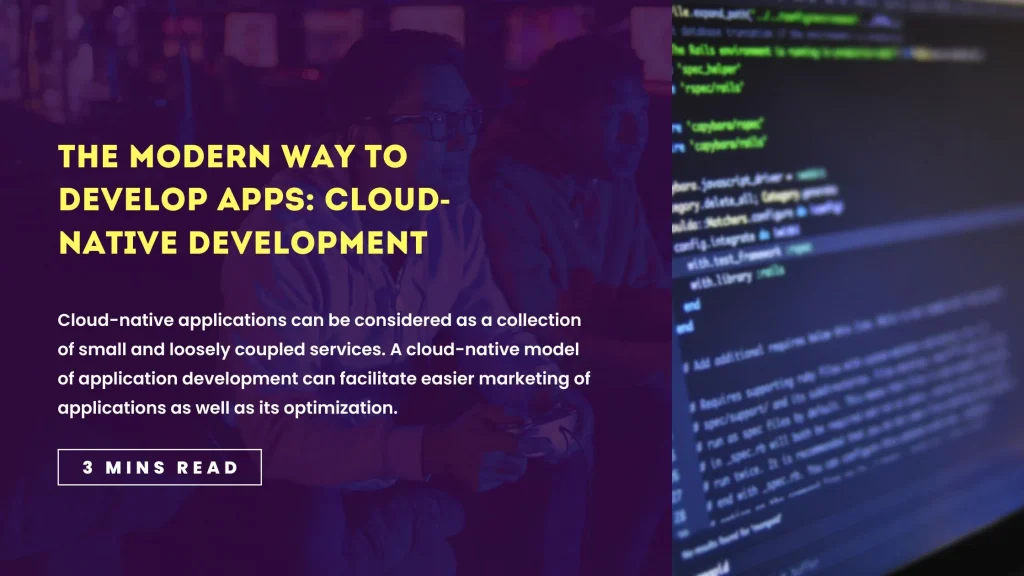Cloud-Native App Development: The modern way to develop apps

Cloud-native applications refer to building and running applications in the cloud. Cloud-native applications are a collection of small and loosely coupled services. A cloud-native model of application development can facilitate easier marketing of applications as well as its optimization. According to a survey by Gartner, 95 percent of the digital workloads will be deployed on cloud-native platforms by 2025. Cloud-native applications are characterized by smaller application life cycles that are easily observable and manageable. Such a model can also pave the way to easy application scalability.
Why Cloud Native App Development?
1) Polyglot
Cloud-native development enables services to be built using multiple languages and frameworks. In cloud-native applications, all the services are loosely paired which enables developers to reap the benefits that are offered by different programming languages and frameworks. The cloud-native architecture thus enables the development of polyglot programs and scripts that can be written in multiple programming languages while at the same time executing and performing operations that are independent of the programming language. Thus the flexibility provided by cloud-native models to use multiple languages helps developers to easily execute those functionalities that demand specific languages in order to build applications faster as compared to the case in which a single language is used.
2) Automation
Automation is one of the linchpin factors that make cloud-native development possible. The Infrastructure as Code (IaC) deployment by the cloud-native model makes it possible to automate the applications. Automation makes it possible to easily run and scale the applications that are based on the cloud. Solutions based on AIOps and MLOps can facilitate faster building, testing, deployment, and monitoring of the applications. Such capabilities can also replace the manual processes and workflows and paves easier and faster automation.
3) Autoscaling
Several organizations prefer the cloud-native architecture because of the auto-scaling opportunities that are presented by it. Such capabilities can help an enterprise to scale their applications automatically depending on the traffic without any manual interventions. The cloud-native model facilitates developers to adopt a flexible strategy for application development. Developers can choose an apt programming language and exploit the latest solutions thus ensuring that developers are not locked into a dependency situation as in the case of deploying traditional application development models.
4) Adaptability
The cloud-native model enables easier and on-the-fly scalability of applications. This can also ensure faster mobility of applications. Scalability involves the ability of an application to handle traffic variations associated with user surges without compromising performance. Most of the cloud service providers offer scalability and mobility that enables anywhere and anytime access. The loose coupling of the cloud-native model facilitates easier and instant changes in an application.
5) Microservices
Microservices refer to loosely coupled and independently deployable software services. The microservice architecture enables developers to create extensible and flexible applications. Microservices facilitate easier updating of applications and can ensure better availability of applications. The microservice architecture enables developers to focus on the core functionality of a service and also enables easier management of the lifecycle of an application.
6) Application Programming Interface
Application Programming Interface (API) can be identified as software connectors that are used to expose the functionality of the software. APIs can facilitate developers to exploit functionalities and customize their applications. Cloud-native APIs can be easily built, managed, and deployed in the cloud environment. Also, they can be easily designed and managed across any cloud environment; private, public, hybrid, and multi-cloud.
7) Agility
Business agility is one of the utmost requirements in today’s world. The cloud-native model of application development is characterized by an independent life cycle for each of the services. The cloud-native model facilitates easier development and shipment of applications. As compared to the monolithic model of application development, the cloud-native model facilitates the deployment of automation capabilities that enables teams to speed up the application delivery.
Conclusion
Cloud-native development has replaced the traditional development model. The business landscape has transformed to such an extent that it is extremely important to ensure fast delivery of applications. Cloud-native models can enable developers to exploit disruptive technologies that can drive the way to easy innovation. The cloud-native architecture also facilitates the fast scalability of applications and paves the way to easier mobility.
Activelobby is a company that provides cloud-native development to clients. As part of our cloud-native development strategy, we offer applications that provide high scalability, mobility, and performance. We also incorporate solutions based on AI and IoT into our products. Our cloud-native development strategy enables clients to accelerate their development process and offer better services to their customers.
Is containerization is used while building a cloud-native application?
As in any product with a cloud-based architecture, Containers are important for scalability and enabling automated deployments.
Containers like Docker standardized the whole cloud development model. Containers are significant for leveraging the benefits of the cloud computing delivery model at the same time your containerization choices should be bound by your business demands
